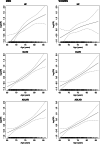Sex differences in factors associated with heart failure and diastolic left ventricular dysfunction: a cross-sectional population-based study
- PMID: 33639910
- PMCID: PMC7912519
- DOI: 10.1186/s12889-021-10442-3
Sex differences in factors associated with heart failure and diastolic left ventricular dysfunction: a cross-sectional population-based study
Abstract
Background: Although sex differences in cardiovascular diseases are recognised, including differences in incidence, clinical presentation, response to treatments, and outcomes, most of the practice guidelines are not sex-specific. Heart failure (HF) is a major public health challenge, with high health care expenditures, high prevalence, and poor clinical outcomes. The objective was to analyse the sex-specific association of socio-demographics, life-style factors and health characteristics with the prevalence of HF and diastolic left ventricular dysfunction (DLVD) in a cross-sectional population-based study.
Methods: A random sample of 2001 65-84 year-olds underwent physical examination, laboratory measurements, including N-terminal pro-B-type natriuretic peptide (NT-proBNP), electrocardiography, and echocardiography. We selected the subjects with no missing values in covariates and echocardiographic parameters and performed a complete case analysis. Sex-specific multivariable logistic regression models were used to identify the factors associated with the prevalence of the diseases, multinomial logistic regression was used to investigate the factors associated to asymptomatic and symptomatic LVD, and spline curves to display the relationship between the conditions and both age and NT-proBNP.
Results: In 857 men included, there were 66 cases of HF and 408 cases of DLVD (77% not reporting symptoms). In 819 women, there were 51 cases of HF and 382 of DLVD (79% not reporting symptoms). In men, the factors associated with prevalence of HF were age, ischemic heart disease (IHD), and suffering from three or more comorbid conditions. In women, the factors associated with HF were age, lifestyles (smoking and alcohol), BMI, hypertension, and atrial fibrillation. Age and diabetes were associated to asymptomatic DLVD in both genders. NT-proBNP levels were more strongly associated with HF in men than in women.
Conclusions: There were sex differences in the factors associated with HF. The results suggest that prevention policies should consider the sex-specific impact on cardiac function of modifiable cardiovascular risk factors.
Keywords: Diastolic left ventricular dysfunction; Elderly; Heart failure; NT-proBNP; Risk factors; Sex differences.
Conflict of interest statement
The authors declare they have no competing interests.
Figures
References
-
- Yancy CW, Jessup M, Bozkurt B, Butler J, Casey DE, Jr, Colvin MM, et al. 2017 ACC/AHA/HFSA focused update of the 2013 ACCF/AHA guideline for the Management of Heart Failure: a report of the American College of Cardiology/American Heart Association task force on clinical practice guidelines and the heart failure Society of Amer. Circulation. 2017;136:e137–e161. doi: 10.1161/CIR.0000000000000509. - DOI - PubMed
-
- Chioncel O, Lainscak M, Seferovic PM, Anker SD, Crespo-Leiro MG, Harjola VP, et al. Epidemiology and one-year outcomes in patients with chronic heart failure and preserved, mid-range and reduced ejection fraction: an analysis of the ESC Heart Failure Long-Term Registry Methods and results. Eur J Heart Fail. 2017:1–12. 10.1002/ejhf.813. - PubMed
MeSH terms
Substances
LinkOut - more resources
Full Text Sources
Other Literature Sources
Medical
Research Materials
Miscellaneous



